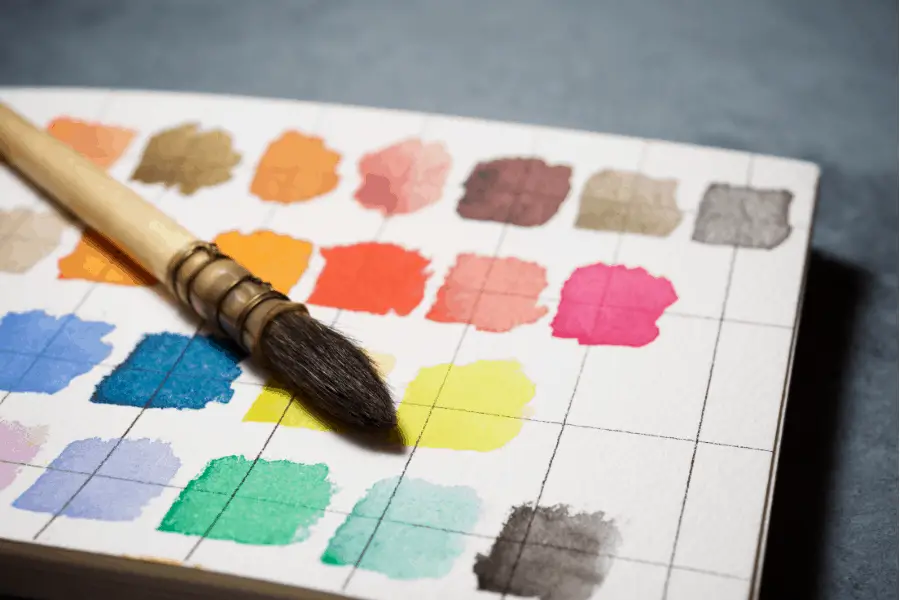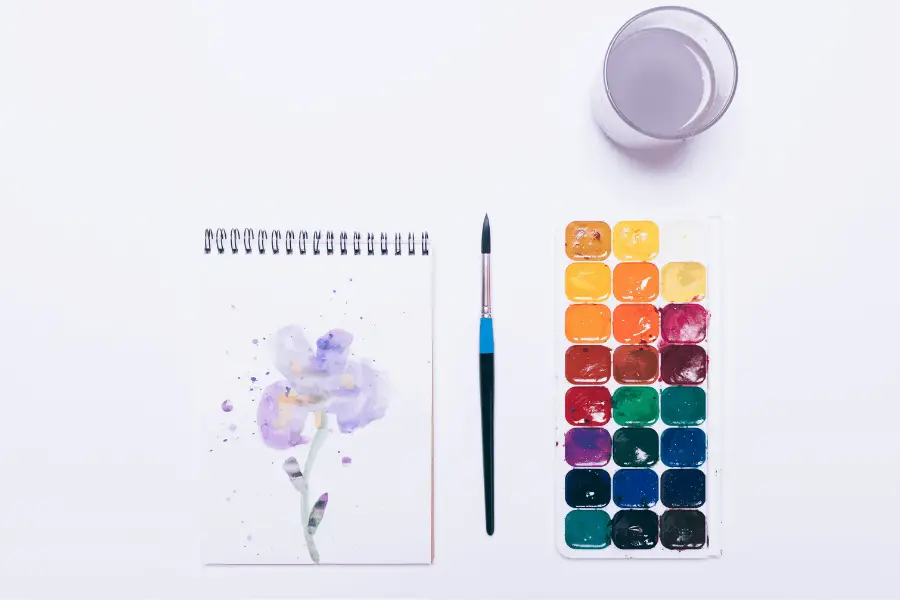Whether you have children, pets, or sensitive skin, selecting non-toxic paint may be a top priority. Because so many paints are made with poisonous ingredients, it can be difficult to find a paint that is safe for your children and furry pets.
So, is watercolor paint toxic? Luckily, watercolor paints are non-toxic and safe. Although you certainly shouldn’t try ingesting it, watercolors tend to be the safest on the market for a variety of people, including parents, pet owners, and those with sensitive skin.
In this article, we explain the potential toxicity of watercolor paint, why this medium is typically considered low risk, and much more. Let’s get to it!
Watercolor Toxicity Explained

In order to fully understand whether or not watercolors are toxic, you need to understand exactly what toxicity is and how it pertains to watercolors and other paints. This step can help you determine whether you, your child, or your pet can safely be around watercolor paints.
My favorite and top pick is always Arteza Watercolor Paints. They have so many different colors, and the quality is amazing! I usually use Arteza Paints for all my projects.

What Does “Toxic” Even Mean?
If the paint is labeled non-toxic, it simply means that there are none, or fairly low amounts of volatile organic compounds within the paint. Volatile organic compounds release gas into the air, which can make them toxic to breathe or consume.
Paints without these compounds are safer to use because they are made with more organic and natural materials.
However, just because something is labeled non-toxic does not mean you should eat it or apply it to your skin. In fact, most items that are labeled non-toxic absolutely should not be consumed or applied to your body since they are not designed for it.
The label simply indicates that the paint does not contain volatile organic compounds.
Another greta option for non-toxic watercolors is this Arteza Half Pan Watercolor Set. Unlike the tubes I recommended above, these come in small pans that can be reused. They are also kid friendly!

Nevertheless, many nontoxic materials are edible, but should not willfully be eaten. All this means is that you can technically eat the material without dying or becoming poisoned. You can still become sick or experience nausea, nonetheless. As a result, nontoxic paints are technically edible but should not be eaten.
Can Watercolor Paint Kill You?

As we already mentioned, watercolor is generally non-toxic to humans. What this means is that the paint does not have any or enough toxic ingredients for it to pose harmful effects on humans. As a result, watercolor paint ranks low on the toxic index.
Watercolor paints tend to have very few volatile organic compounds. To put this in perspective, some paints have as many as 10,000 chemicals in them. This makes watercolors a much more non-toxic form than other paints.
With that being said, you certainly should not try ingesting watercolor paint, though we’re not sure why you would want to. Even though watercolors are generally low toxic, they are still not intended to be ingested by humans or animals.
This is especially true since some watercolor paints are more toxic than others. For example, certain pigments require more toxic ingredients to get the rich color you want.
Children’s watercolor paints, on the other hand, have less toxicity. Most watercolors that include toxic ingredients will be labeled as such, making it easy to identify which pigments you need to be more careful with.
My kids have this Arteza Kid’s Watercolor Set. They are non-toxic and also conform to ASTM D-4236, which provides parents a peace of mind.

Because certain watercolor paints are more toxic than others, it is a general rule of thumb to avoid ingesting any type of watercolor. Once again, the paint is technically edible but should not be eaten.
If you do happen to ingest a little bit, you most likely won’t be harmed in any way. The biggest danger lies in large quantities of consumption.
Is Watercolor Toxic to Pets?

Generally speaking, watercolors are just as toxic to pets as they are to humans, meaning that they aren’t very toxic, but you still don’t want your pet to ingest them. In other words, try to care for your paintings and watercolor painting materials in a way that prevents animals from getting ahold of them.
For example, many cats love to lie on painting palettes. To prevent your cat from licking the palette, rinse it off as soon as you are done painting. This will prevent your cat from licking the paint off the palette as they are lounging.
Similarly, dogs will eat just about anything they can get their mouth on. That’s because dogs typically use their mouth and tongue to experience the world, much like we do our hands and fingers.
To prevent your dog from eating your watercolors, make sure to store them in an area where dogs cannot have easy access.
If your dog or cat happens to take a bite or lick out of your watercolors, try to rinse their mouth out. If they only consumed a small amount of watercolor paint, your pet will likely be fine, though they might cough and try to get the taste out of their mouth.
For larger consumptions, your pet may get sick. In most cases, nausea and vomiting may occur, but your pet should not experience anymore long term reactions.
If you are concerned, you can always contact your veterinarian. They will be happy to help.

Other animals typically have the same sort of reactions to watercolor paints, though dogs and cats are the most likely to consume it. Birds, small mammals, and reptiles are typically housed away from the paint, which makes them less likely to consume it in the first place.
If your exotic pet gets ahold of watercolors, expect them to have the same sort of reactions, though their size may impact their tolerance.
Is Watercolor Toxic to Cats?

Cats love to lay in some of the weirdest spots, including on your watercolor palette. If your cat happens to lay on a dirty palette or ingest some of the watercolor paint, you can expect a few reactions, though they are not very common.
Most notably, water-based paints can irritate cat’s skin and their mucous membranes. So, your cat can get a rash after laying on the paint or palettes with old paint on it. The reactions are not long-lasting.
Washing your cat’s skin can go a long way in terms of treatment, but prevention is the best method.
As for toxicity and poisoning, watercolors are not expected to cause any adverse reaction if your cat consumes a little bit. However, your cat may experience nausea and vomiting if they eat large amounts of watercolor paint. Large ingestion should not lead to long-term consequences. Once your cat throws up, it should be back to normal.
Is Watercolor Toxic to Dogs?

Watercolor toxicity in dogs is very similar to its toxicity in cats. The most adverse reaction dog’s experience to watercolor paint is typically related to topical exposure.
If your dog touches the watercolor paint, they may experience some rashes or itches. Wash the exposed skin thoroughly. If the rash isn’t going away, contact your veterinarian for a cream or topical ointment.
Watercolor paints are not poisonous for dogs to consume either. In small quantities, your dog should not experience any adverse reactions. If they consume large amounts of watercolor paint, they may become nauseous or even vomit, but the adverse reactions stop there.
Is Watercolor Toxic to Skin?

Even though watercolor paints are considered non-toxic, they are not safe on the skin. Non-toxic simply refers to the likelihood of poisoning once ingested or breathed. If you put the watercolor on your skin, you are obviously not ingesting or breathing it, meaning that the nontoxic label means nothing for skin exposure.
For people with sensitive skin or skin conditions, watercolor paints may cause irritation and sensitivity. For someone with eczema or perioral dermatitis, watercolor paints can irritate the skin a little bit, but the symptoms should be manageable.
Simply washing the paint off the exposed area and putting on an anti-itch cream should do the trick. If you have more severe skin conditions or allergic reactions, you may need topical ointments or prescription medication.
Just because some people may react to watercolor paint, it doesn’t mean everyone will. People who do not have sensitive skin may not experience any form of reaction to the watercolor paint. Still, it is best to avoid exposing your skin to the paint since you don’t know how sensitive you can be to it, until after it’s too late.
If you are concerned about your skin reacting to watercolor paint, most children’s watercolors are much gentler on the skin. As a result, children’s watercolor is generally a very gentle and safe artistic medium for children, even those with skin sensitivity.
Final Thoughts
All in all, watercolor paints are considered non-toxic, but you should not ingest them, and you should be careful when exposing your skin to paint. Just because the paint is considered non-toxic does not mean it won’t make you feel bad upon consumption or cause an allergic reaction.
Nevertheless, watercolor paints are a great paint medium to choose if you have children, pets, or sensitive skin. Its low toxicity levels mean that it creates fewer adverse reactions.
Don’t forget to check out my other articles for all your painting Q&A’s. Happy painting!


